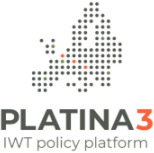Executive summary
This deliverable identifies and analyses the main existing barriers in inland waterways (IWW) and port infrastructure projects implementation, both on national and international (EU) level. The main focus is put on barriers related to funding as one of the most important obstacles to inland waterway transport (IWT) infrastructure implementation.
In line with the main objective of this task, an assessment was conducted with respect to existing barriers relating to the inland waterway infrastructure, fairway infrastructure, as well as inland port infrastructure. The deliverable takes into consideration not only constraints (administrative and technological barriers) inherent to construction processes, but also aspects of climate change, global warming and emergence of correspondent regulatory measures implemented on EU level.
However, not only barriers are described in the report, but also existing good practices and successful examples of projects implementation in combination with measures tackling these barriers. In addition, the work was amended by input collected during the PLATINA3 4th Stage event in Strasbourg, in particular, from the discussions during the dedicated panel: “How to make sure that (more) IWT projects are raised, financed and implemented?”. The research is complemented by recommendations on potential elimination of the barriers on operational and regulatory level, proposing possible adaptation of the existing framework to diminish barriers for IWT infrastructure and facilitate projects’ implementation to ensure modal shift towards IWT.
The report is structured across four main topics:
- Technological and regulatory barriers, in particular in relation to the complexity of the environmental legislation – on national level (depending on the national legislation in the field of environmental protection), on EU-level and on cross-border level (when legislation differs from one state to another).
- Barriers on funding and financing, issues related to attraction of investments to IWT infrastructure projects, also touching upon regulatory and policy aspects, especially in relation to climate proofing and climate change mitigation and adaptation measures.
- Administrative and regulatory barriers, addressed on national level, EU level, and in case of cross-border projects – international level when several countries (EU or EU and non-EU Member States) are involved.
- Institutional barriers related to institutional capacity constraints, lack of engineers, technical experts and infrastructure managers.
The given structure is reflected in the framework of the report, consisting of eight chapters. While the first chapter provides an overview of the overall objectives of the report, scope and accepted methodology, the second chapter is focusing on modal shift and the role IWT infrastructure plays in it. The following four chapters are dedicated to the aforementioned categorized barriers. The seventh chapter is complementing the analysis conducted in the previous chapters and summarizes the recommendations of the deliverable, focusing on four areas: environmental, regulatory (in relation to funding), institutional and administrative.
The environmental perspective is evaluated from the position of the sector, which always was focusing on ensuring the balance between navigability and sustainability. The search for measures to create a sustainable inland waterway infrastructure has always been an important issue, as freshwater ecosystems being considered endangered and species protection and nature conservation as a whole must be ensured not only for the sake of the environment, but also for the sake of navigation. The inland navigation sector has always been confronted with various challenges. On the one hand, integration of IWT into multimodal supply chains through the maintenance of fairways and canals, the expansion of inland waterways, and the creation and operation of additional port infrastructure (ensuring road and rail connectivity). On the other hand, the implementation of sustainable solutions to ensure preservation of water bodies and tackling climate change has to be undertaken.
Today environmental issues become more and more urgent, requiring a proper addressing of existing problems through both: structural and non-structural measures to avoid causalities, to lower the negative impact brought by construction, as well as through integration of new findings on an accelerating climate change into adaptation strategies. It is clear that no solution fits all, and measures have to be considered in a case-by-case manner. River adaptive capacities have to be assessed on a river basin level in a comprehensive way. This can be done through exploring funding opportunities on EU-level (CEF, operational programs) to conduct studies on integrated environmental measures in the design of the projects not only for the sake of biodiversity conservation, protection of species and environmental protection, but also building adaptive capacity of river engineering measures and infrastructure management for a particular river basin.
On the other side, there is the optimization of the IWT infrastructure network in terms of port infrastructure and fairway depths (Good Navigation Status, GNS). Operations in connection with IWT significantly depend on the prediction of water levels and availability of adequate water depths. Temporary blocking of waterway sections has to be avoided and prevented, ensuring uninterrupted operations throughout the year. Otherwise, such disruptions are seriously undermining the capacity of IWT and decreasing the attractiveness and competitiveness of this type of transport.
This means that solutions have to be found regarding a further integration of transport and environmental policies, as well as a strategic vision for sustainable strategic development of IWT has to be established. The European Green Deal (EGD), the Sustainable and Smart Mobility Strategy (SSMS), as well as NAIADES III are emphasizing the important role IWT plays in sustainable transportation transition. At the same time, the implementation of IWT infrastructure projects is often facing opposition in terms of environmental aspects, meaning that the bridges between environmental legislation and IWT policy have to be built to bring more balance into decision-making and the necessary political support at both national and international level.
From the perspective of funding, reliable and efficient instruments are key when it comes to the development of any kind of an infrastructure project. The deliverable presents certain cases on funding issues related to the implementation of IWT infrastructure in the Danube and Rhine regions and certain peculiarities of obtaining EU-funding for the implementation of CEF-funded cross-border projects between EU and non-EU Member States too.
From the perspective of inland port projects, results of the research conducted in 2021 by the Rhine-Danube Corridor Study Team led by iC consulenten and by the DTP DIONYSUS project are given to provide an overview on the development of the port infrastructure in the Rhine-Danube Corridor. The research showed a comparison of funding dedicated to IWT port projects with the one of projects relating to other transport modes. The analysis revealed that the vast majority of inland port projects fall into the category of project costs between €1 million and €50 million, which is significantly less capital intensive than projects in the rail or road sector.
Furthermore, the fourth chapter provides an overview of the existing funding issues, also analyzing the new legislation supporting sustainable economic activities (such as theGuidelines on State aid for climate, environmental protection and energy and the Taxonomy Regulation). Another important document – the Technical Guidance on climate proofing of infrastructure in the period 2021-2027, was assessed from the perspective of a holistic methodology it brought to ensure that an IWT project subject to EU-funding is covering the aspect of climate change. Together with this, it means that another possibility to ensure funding for IWT infrastructure is given by the combination of engineering and environmental measures under one project. It is also emphasized that for many projects, budgets are often allocated to individual works for either construction or upgrade of infrastructure facilities, while a variety of current instruments for EU-funding allows the combination of the primary objectives of infrastructure projects relating to transport with other ones eligible for EU funding like climate change mitigation and adaptation, as well as energy transition. A combination of budgets for one IWT infrastructure project covering several objectives can be a solution to tackle the issue of budgetary constraints. Examples on grouping of budgets were provided on the renovation of the Ijmuiden Sea lock in the Netherlands and on the reconsideration of the system on the Meuse River.
The institutional barriers perspective is evaluated for various stages of IWT infrastructure projects implementation, through approvals, decision-making and permitting procedures, in certain cases, negotiations on national, international or EU-level. By being conservative in methods of handling infrastructure projects and overall functioning of the transport system, governmental institutions can be reluctant in terms of adoption of modern approaches, and restrain learning, for example, by imposing strict compliance to existing rules and procedures. Yet, the other way around, these structures can also enable learning, for instance, through stakeholders’ involvement and interactive decision-making.
Institutional constraints often play a role of an important limiting factor even when overall transport policies are in favour of IWT. Therefore, the political will shall be backed up with relevant capabilities (including institutional capacity) of various governmental, public and private stakeholders to eliminate barriers in IWT infrastructure implementation as well as bringing modern state-of-art solutions to IWT on a continuous basis with concrete results. An iterative approach shall be brought in practice in combination with existing successful practices on the governance structure and institutional capacity of a country.
Good practices, such as the importance of education and training for ensuring ecologically sound river engineering were presented. There are different levels of impact and different requirements when it comes to education for all aspects of the complex river system. A shift from a subject based education to sciences integration shall be duly addressed and embedded in the educational processes as well as in regular training programs to build-up and to reinforce existing institutional capacity in the IWT sector. A double-loop learning in order to better understand modern IWT infrastructure needs to be put in practice by reconsideration of its original aims, implying interdisciplinary and an integrated approach. Both single-loop and double-loop learning are considered essential, while existing functionalities of IWT infrastructure can be optimized and potentially transformed, to refine and develop new approaches to accommodate extreme weather events (e.g., creating either robust waterworks or more flexible designs).
The most common administrative barriers related to infrastructure projects’ implementation at different stages, such as various procedures in terms of certification, due diligence, permits, public procurements, tender biddings, contracting and planning are given in the deliverable. They often go close with the aforementioned complex hierarchy of the institutional system and international character inherent to a large number of IWT infrastructure projects. The vast majority of administrative barriers stems from institutional complexity and procedures, which are following the established hierarchy, defined on the national level of EU Member States. In many cases, for large infrastructure projects, and especially for cross-border projects (with involvement of several Member States, budgetary approvals, technical and administrative complexity of permit granting procedures, public procurements etc.), this complexity is understandable as it relates to large investments, public funding and complex decision-making. It is obvious that major infrastructure projects take a long time.
Very often due to the lack of communication, low involvement of public authorities in the early stages of setting up a project, long discussions and argumentations at later stages affect significantly the timely preparation and implementation of a project causing delays. In this regard, an open planning process (especially if substantial environmental impact is expected) and early involvement of all relevant stakeholders to participate in the scoping process and to contribute to identifying alternatives will help to reconcile or reduce conflicting interests and to lower risk of delays at later stages. The stakeholder involvement process is the responsibility of the project promoters and respective authorities in charge. Thus, a better promotion of the positive impacts of IWT due to its high energy efficiency contributing to the climate objectives can lead to a higher acceptance of the proposed infrastructures by environmental authorities and the society. The involvement of local stakeholders can be a good tool to avoid opposition and to increase awareness of the benefits of a project.

